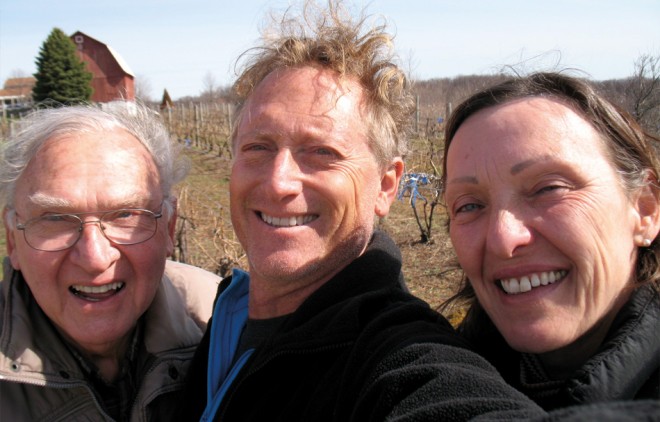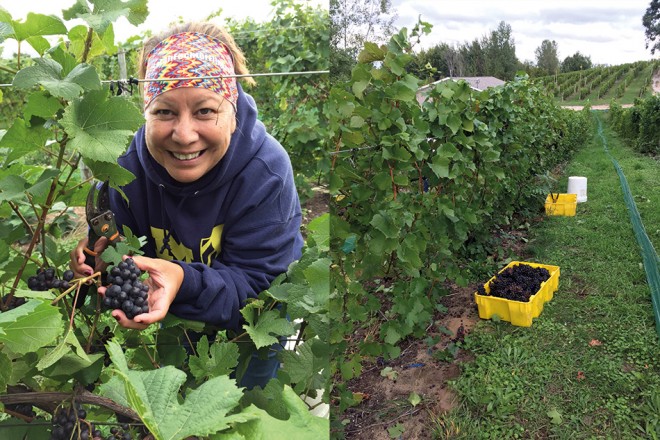Discovering a wine region in the manner in which I prefer can take the form of piggybacking vineyard and winery visits onto an already established event. It was at an annual gathering of Michigan’s wine communicators organized by the Leelanau Peninsula Wine Trail (LPWT) that allowed me this opportunity.

Having motorcycled the circumference of Lake Michigan in 1996 when living in Chicago, I’d fond memories of the Michigan’s woodlands, meadows, and farms at which could be found cherry orchards and the occasional vineyard. At that time there was nascent interest in developing the cherry sector for distilling, while quality vinifera wine production was in its infancy in this US state accustomed to growing hybrid grapevines. As with many burgeoning wine regions in the US and elsewhere climate change, individual inspiration, greater shared research, and better technology have spurred the production of fine wines in new locations.
Michigan’s second American Viticultural Area (AVA) is Leelanau Peninsula (LP), dates to 1982 while its neighboring AVA, Old Mission Peninsula (OMP), was established in 1987. The 34 wineries located on the twin AVA’s 180-360m elevation possess a surprising diversity of soil types based upon glacial moraine with striated variations–clays of various colours, silica, sandy loam, gravel and pulses of granite and limestone. With nearly 2,600 aggregate growing hours, more sunlight in the critical ripening month of July than more southerly US wine regions, diurnal swings as wide as 30°F, and its relatively narrow land mass positioned between large bodies of fresh water lakes creates an area—when not buffeted by the vagaries of weather—uniquely suited to producing a plethora of delicious cool climate whites and sometimes reds.
The region’s largest town of Traverse City is a foodie destination with noted chef Mario Batali summering there. Native Michiagn rockers Mark Farner and Bob Seger have residences in this generations-old summer holiday locale, while noted Academy Award-winning documentarian Michael Moore not only resides year-round but has been instrumental in the development of the city’s popular annual film festival. Dinner at its Trattoria Stella with the LPWT’s director Lorri Hathaway and Lee Lutes, winemaker and managing member of Black Star Farms, consisted of mixed offal from pig, lamb, and cow (very unusual for the US!) accompanied by an aromatic Brengman Brothers Gewurztraminer. “We celebrate vintage variation here; in the better vintages you’ll recognize vaster differences than you would on the US West Coast” said Lutes. “For some wine lovers it’s problematic, but I like to think diversity is part of wines’ pleasure.”
Later tastings of Black Star Farms showed great examples within the Arcturos brand: a lees-stirred Pinot Gris with extended skin contact, a balanced and age worthy semi-dry Riesling, and an unoaked Chardonnay subjected often to lees stirring.
Known since their 2007 inception for snappy Rieslings, fine Chardonnay, and the aforementioned Gewurztraminer Ed & Rob Brengman this August launched a fortified wine brand (a Michigan winery first) entitled ‘Piccolo Dito’, an homage to the land mass the Traverse City-based vineyard/winery rests upon. An Amaro, Mistela, and Sweet Vermouth are fashioned by winemaker Nathaniel Rose from all-Michigan wines and spirit with herbs used in the Amaro and Vermouth harvested from Michigan and beyond. Joined by Master Sommelier Brett Davis of Kentucky the Brengmans and Rose are soon to launch a wine bar/shop outlet in Michigan’s second largest city of Grand Rapids.

Michigan’s largest wine producer is Leelanau Wine Cellars which farms 120 acres but also acquires grapes from throughout the state. “When you have a growing wine region with more buyers than sellers, there’s always someone willing to pay a dollar more,” says owner Bob Jacobson. Jacobson’s Sauvignon Blanc, culled from an acre owned by his family, is brisk, varietally correct, and immensely refreshing—even on an unseasonably chilly late April afternoon.
But the twin LP/OMP peninsulas aren’t focused solely upon still wines. Arguably the state’s most famous winemaker is sparkling wine stalwart Larry Mawby. His top wines, including the traditional method ‘Mille’ from 100% Chardonnay, are bottled with the L. Mawby label while the M. Lawrence moniker adorns labels which include the rosé ‘Sex’, a bottling garnering him unwanted attention only from the US government as well as praise from sparkling wine author Tom Stevenson.
Pinot Noirs from LP’s Bel Lago and OMP’s Chateau Chantal show diversity of flavor and style this northerly latitude offers; Bel Lago’s is brooding and chewy as befits its sourcing from a Dijon clone; by contrast, Chantal’s emphasizes elegance and poise. A rosé version from newcomer Verterra is Michigan’s best pink with its Cabernet Franc rosé a solid second; this new winery also fashions tasty Pinot Blancs and Rieslings while, as other wineries in the Twin Peninsulas, struggles for consistent world-class Cabernet Franc in its red form.
Odder offerings can also be found. The aforementioned Lutes work with Grüner Veltliner as do his Leelanau neighbors Shady Lane and Chateau Fontaine; Bel Lago has surprinsingly rich and balanced Auxerrois and a Marsanne/Roussanne blend; while the flagship wine from Ciccone Vineyard & Winery, run by father Tony and daughter Paula (with occasional visits from famed family member Madonna) is a Dolcetto-Michigan’s only planting of the Piedmontese red.